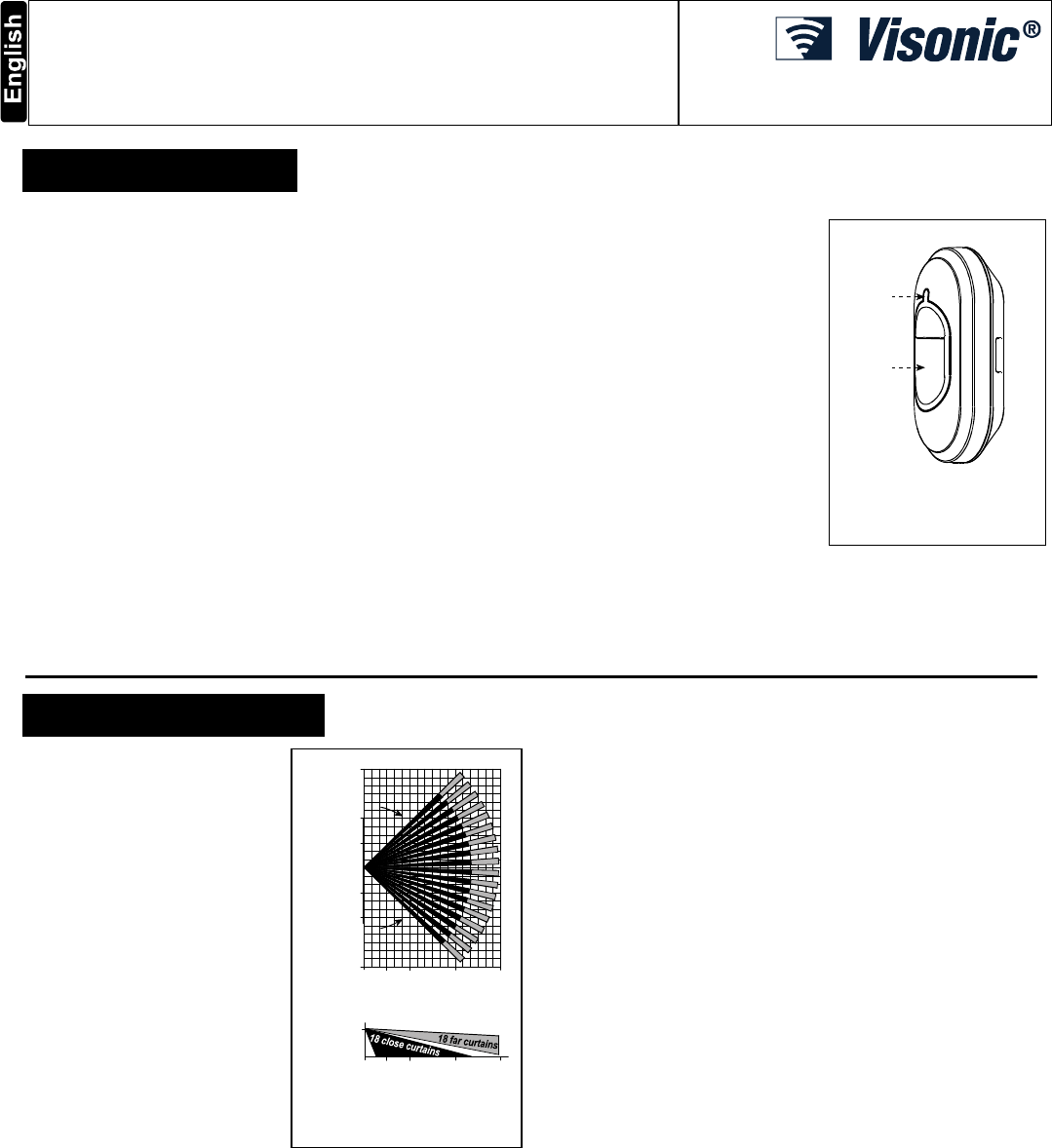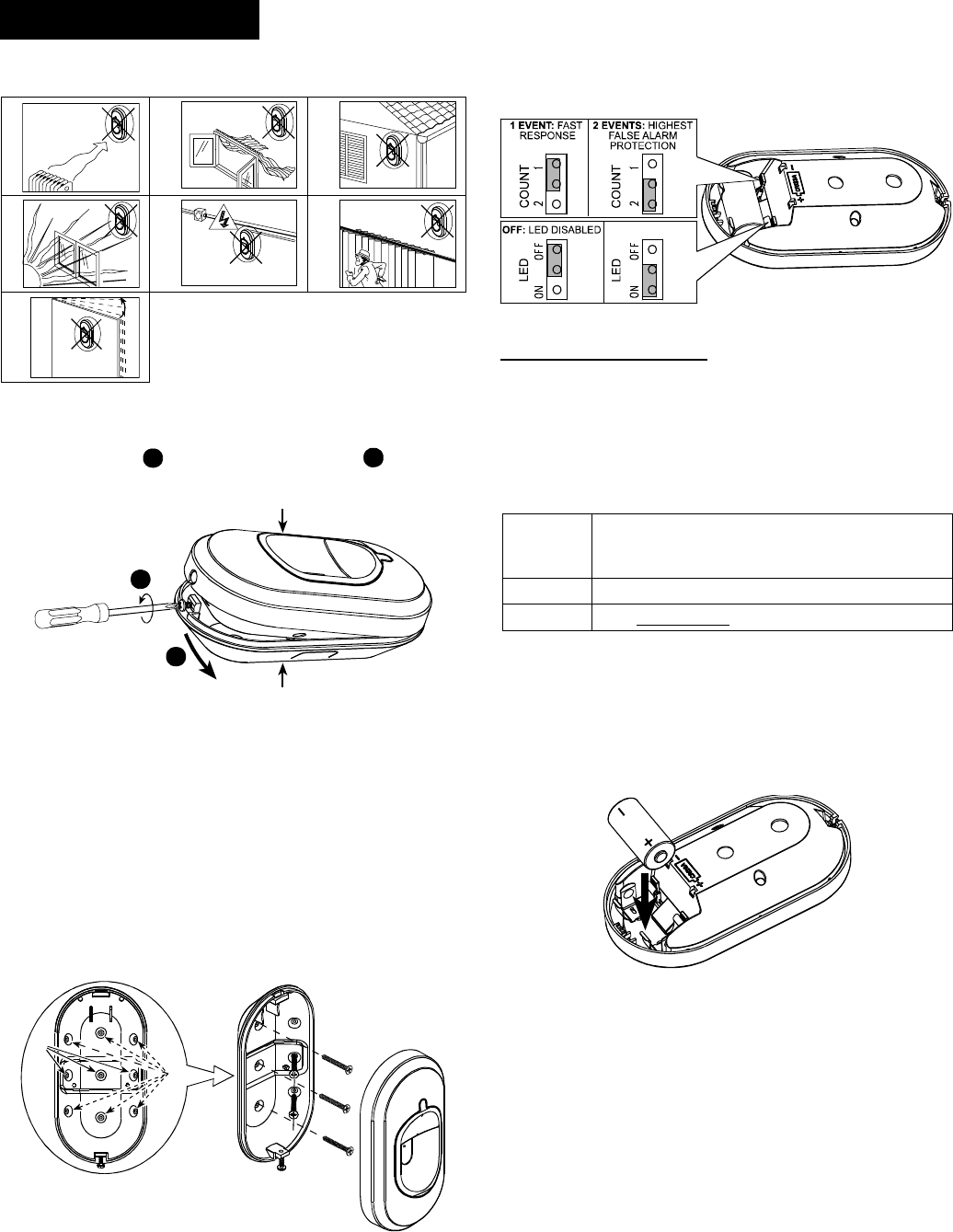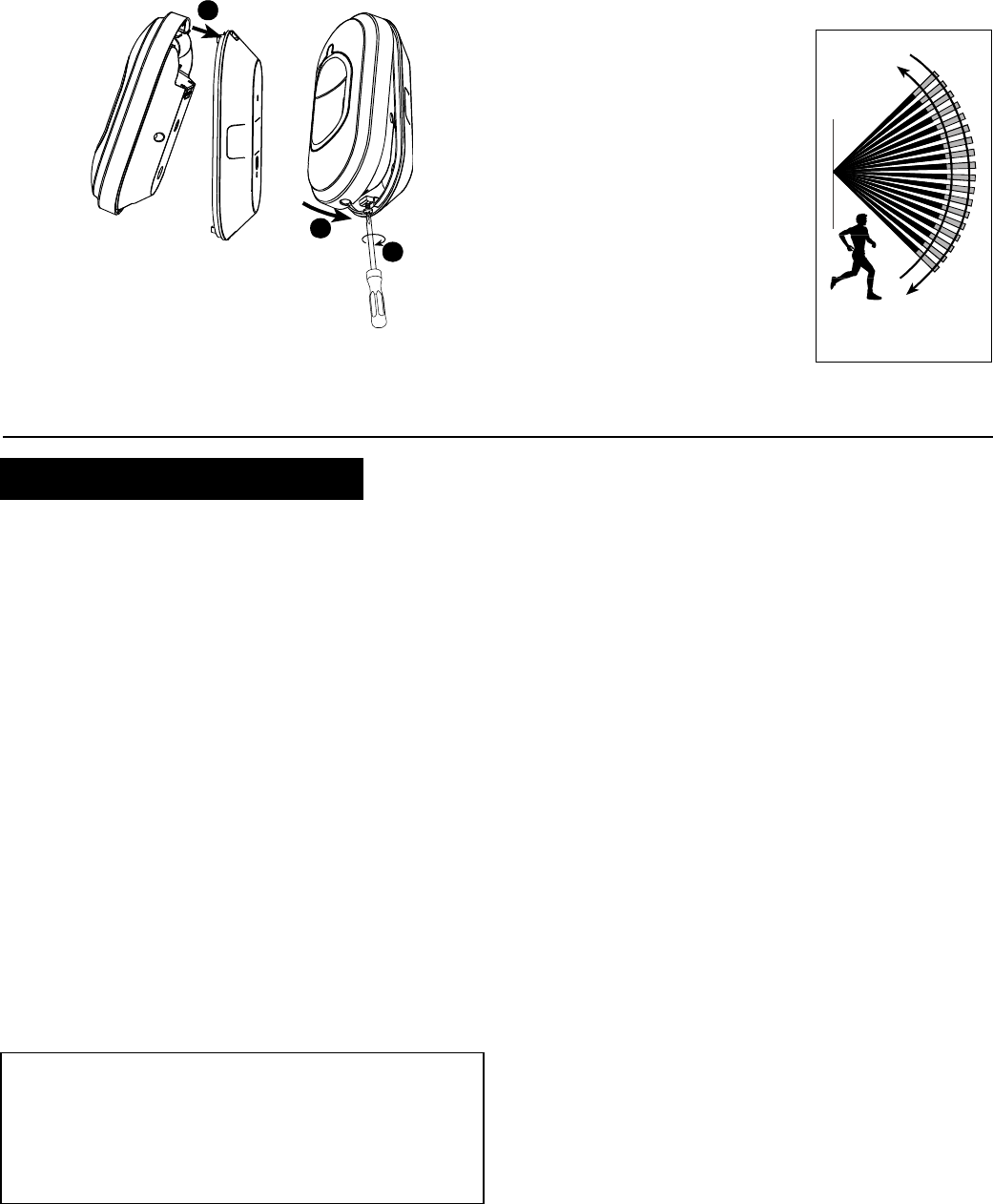Visonic TOWER40 Wireless PowerCode Digital Mirror PIR Detector User Manual
Visonic Ltd. Wireless PowerCode Digital Mirror PIR Detector Users Manual
Visonic >
Users Manual

D-300430 1
TOWER 40
Wireless PowerCode Digital Mirror PIR Detector
Installation Instructions
1. INTRODUCTION
The TOWER 40 is a microprocessor-controlled wireless digital PIR
detector, designed for easy installation, free of vertical adjustment.
It features parabolic and cylindrical mirrors with uniform detection
sensitivity throughout its operating range, up to 18 meters (59 ft),
with creep zone protection.
The advanced True Motion Recognition™ algorithm (patented)
allows the TOWER 40 to distinguish between true motion of an
intruder and any other disturbances which may cause false alarms.
An on-board motion event jumper determines whether 1 or 2
consecutive motion events trigger an alarm.
The TOWER 40 includes the following features:
• Incorporating patent pending black mirrors for extremely high
white light immunity.
• Advanced elliptical / parabolic mirror technology (patent
pending).
• Provides multiple curtain coverage (patent pending).
• V-slot® optic technology (patent pending) for improved
robustness, anti-vandalism and for very high reliability.
• The entire electronic circuit is enclosed in the front cover with
the optics. The sensor element is isolated from gusts of wind
and insects.
• Creep zone protection.
• Back tamper switch to prevent
unauthorized removal from wall.
• Incorporates a fully supervised
PowerCode transmitter.
• Sophisticated frequency domain
digital signal processing.
• No vertical adjustment is needed.
• Battery compartment for easy
battery replacement without
access to the electronic circuit.
• Programmable motion event
counter.
• Specially constructed against
vandalism.
•
Very low current consumption
(1)
(2)
1. LED
2. Mirror
Figure 1. General View
• Sealed chamber protects the optical system.
• Tamper switch for detector opening / removal alert.
• Improved white light protection.
• Elegantly styled, sturdy case.
2. SPECIFICATIONS
Detector Type: Dual element low-
noise pyroelectric sensor.
OPTICAL (see Figure 2)
Mirror Data:
No. of Beam Elements:
18x3=54 far parabolic mirror
segments.
No. of Curtain elements: 18
Max. Coverage: 18 m (59 ft) / 90°
White Light Immunity: Above
20000 lux
ELECTRICAL
Internal Battery: 3V Lithium
battery, type CR-123A. For UL
installations, use Panasonic or
Sanyo only.
Nominal Battery Capacity:
1400 mA/h.
Battery Life (with LED on):
Typically over 3 years.
12m (39ft) TOP VIEW
90°
3 6 18m010 19 39 59ft
12
0
6m (19ft)
12m (39ft)
6m (19ft)
0
SIDE VIEW
2.4 m
(8 ft)
3 6 18m
10 19 39 59ft
12
3m (10ft)
3m (10ft)
Figure 2. Coverage Pattern
Battery Power Test: Performed immediately upon battery
insertion and periodically after every several hours.
FUNCTIONAL
True Motion Event Verification: 2 position selector - 1 (OFF) or
2 (ON) motion events.
Visual Indications:
LED Lights for about 3 seconds upon transmission of alarm &
tamper messages and upon motion detection in the walk test
mode.
LED Flashes during the power-up stabilization period, or after
restoring (pressing) the tamper switch.
LED Does not light upon transmission of supervision
messages.
Rearm Timer: Rearms the detector 2 minutes after the last motion
detection. The detector reverts to the initial state if there is no
movement during 2 minutes. The timer is disabled in the walk test
mode.
WIRELESS
Frequency (MHz): 315 (U.S. version), 433.92, 868.95, 869.2625
or other frequency according to local requirements.
Transmission Sequence: 3 data bursts at variable / random
intervals within 3 seconds.
Encoding: Over 16 million possible combinations.
Total Message Length: 36 bits.
Supervision Message: Signaling at 60-minute intervals (U.S.
version) or 15 minute intervals (UK version), or according to the
local standards.
MOUNTING
Height: 1.8 - 2.4 m (6 - 8 ft).
Installation Options: Surface or corner.
ENVIRONMENTAL
RFI Protection: >10 V/m up to 2000 MHz.
Operating Temperatures: -10°C to 50°C (14°F to 122°F).
Storage Temperatures: -20°C to 60°C (-4°F to 140°F).
Compliance with Standards: Designed to meet FCC Part 15
and Directive 1999/5/EC of the European Parliament.
EN 50131-2, Grade 2, Class II
PHYSICAL
Size (H x W x D): 122 x 63 x 42 mm (4-13/16 x 2-1/2 x 1-11/16”).
Weight (with battery): 114 g (4 oz).
Color: White.
PATENTS
U.S. Patents 5,693,943 z 6,818,881 (other patents pending).

2 D-300430
3. INSTALLATION
3.1 General Guidelines
Do Not Install in the Following Locations:
3.2 Illustrated Installation Procedure
A. Rear Cover Removal
Release the screw
1
and remove the rear cover
2
, as shown
below.
2
1
Front section
Rear cover
Figure 3 - Rear Cover Removal
Warning: Do not open the detector internal cover!
B. Mounting (see figure 4)
The detector can be mounted on a surface / corner, at height of
1.8 - 2.4 m (6 - 8 ft).
Place the detector rear cover on the mounting surface / corner.
Mark and drill 2 holes in the mounting surface / corner, insert wall
anchors and fasten the rear cover with 2 screws.
Caution To ensure proper functioning of the back tamper switch,
one of the screws should be in the break-away segment (see
point A in the illustration above).
Warning: The top of the detector (see below) must point
upward!
(B)
(A) TOP
Figure 4 - Mounting
Legend
(A) Marking / drillings locations (left / centre / right) in back
tamper break-away segment.
(B) Other Marking / drilling locations.
C. Jumpers Settings
Set event count jumper and LED jumper as required, as
described in the following illustration:
ON: LED ENABLED
Figure 5 - Jumpers Settings
LED Functions Summary
After battery insertion and rear cover closure, the LED flashes for
2 minutes approximately until the detector stabilizes.
After stabilization, the detector enters automatically walk-test
period of 15 minutes (see par. G below). In this mode the LED
lights and the unit sends an RF alarm signal on every detection
(regardless of LED jumper position).
After the walk-test period, the LED operates according to the LED
jumper setting, as follows:
LED
Jumper
Position LED Activity in "Normal Mode"
ON LED lights during alarm transmission.
OFF LED does not light during alarm transmission.
After the first 15 minutes, after every motion detection and alert
transmission, the detector disarms itself to save battery power. It
rearms (reverts to the ready state) if there is no subsequent
detection during the following 2-minute period. Therefore, if you
want to check the detector, you have to exit the room for at least
2 minutes and then enter the room.
D. Battery Insertion
Insert the battery as shown below. Verify proper polarity.
Figure 6 - Battery Insertion
E. Detector Closure
Close the detector and secure with the screw as shown below
(follow the numbered steps).
Wait for the detector to stabilize (the LED stops flashing).

D-300430 3
2
1
3
Front section
Rear cover
Figure 7 - Detector Closure
F. Enrolling
In order that the PowerMax+ or PowerMax Pro will identify the
detector signal, perform enrolling as described in the PowerMax+
or PowerMax Pro installer guide, respectively.
G. Walk-Test
After closing the cover and after the
detector stabilization period (2 minutes
approximately), the detector enters a 15
minute walk-test mode. In this mode,
the LED flashes each time a motion is
detected, regardless of LED jumper
settings and the detector transmits the
occurrence of each event.
Walk across the far end of the coverage
pattern in both directions. The indicator
should light for 3 seconds
approximately each time your motion is
detected.
Important: Instruct the user to
perform walk-test at least once a
week to assure proper detector's
function.
Figure 8 - Walk-Test
4. SPECIAL COMMENTS
4.1 Product Limitations
Visonic Ltd. wireless systems are very reliable and are tested to
high standards. However, due to their low transmitting power and
limited range (required by FCC and other regulatory authorities),
there are some limitations to be considered:
A. Receivers may be blocked by radio signals on or near their
operating frequencies, regardless of the code selected.
B. A receiver can only respond to one signal at a time.
C. Wireless equipment should be tested regularly to determine
whether there are sources of interference and to protect
against faults.
D. Even the most sophisticated detectors can sometimes be
defeated or may fail to warn due to: DC power failure /
improper connection, malicious masking of the lens,
tampering with the optical system, decreased sensitivity in
ambient temperatures near that of the human body and
unexpected failure of a component part.
The above list includes the most common reasons for failure
to detect intrusion, but is by no means comprehensive. It is
therefore recommended that the detector and the entire alarm
system be checked weekly, to ensure proper performance.
E. An alarm system should not be regarded as a substitute for
insurance. Home and property owners or renters should be
prudent enough to continue insuring their lives and property,
even though they are protected by an alarm system.
4.2 Compliance with Standards
The 315 MHz version of this device complies with Part 15 of the
FCC Rules. Operation is subject to the following two conditions: (1)
This device may not cause harmful interference, and (2)
This device must accept any interference received, including
interference that may cause undesired operation.
WARNING! Changes or modifications to this unit not expressly
approved by the party responsible for compliance could void
the user's authority to operate the equipment.
The digital circuit of this device has been tested and found to
comply with the limits for a Class B digital device, pursuant to
Part 15 of the FCC Rules. These limits are designed to provide
reasonable protection against harmful interference in residential
installations. This equipment generates uses and can radiate
radio frequency energy and, if not installed and used in
accordance with the instructions, may cause harmful interference
to radio and television reception. However, there is no guarantee
that interference will not occur in a particular installation. If this
device does cause such interference, which can be verified by
turning the device off and on, the user is encouraged to eliminate
the interference by one or more of the following measures:
– Re-orient or re-locate the receiving antenna.
– Increase the distance between the device and the receiver.
– Connect the device to an outlet on a circuit different from the
one which supplies power to the receiver.
– Consult the dealer or an experienced radio/TV technician.
4.3 Frequency Allocations for Wireless
Devices in European (EU) Countries
• 315 MHz is not allowed in any EU member state.
• 433.92 MHz has no restriction in any EU member state.
• 868.95 MHz (wide band) is allowed in all EU member states.
• 869.2625 MHz (narrow band) is not restricted in any EU
member state.
4.4 Battery Handling
A. Replace battery ONLY with recommended battery (see
specifications).
B. Dispose used batteries according to their manufacturer's
instructions.

4 D-300430
WARRANTY
Visonic Ltd. and/or its subsidiaries and its affiliates ("the Manufacturer") warrants its
products hereinafter referred to as "the Product" or "Products" to be in conformance with
its own plans and specifications and to be free of defects in materials and workmanship
under normal use and service for a period of twelve months from the date of shipment by
the Manufacturer. The Manufacturer's obligations shall be limited within the warranty
period, at its option, to repair or replace the product or any part thereof. The Manufacturer
shall not be responsible for dismantling and/or reinstallation charges. To exercise the
warranty the product must be returned to the Manufacturer freight prepaid and insured.
This warranty does not apply in the following cases: improper installation, misuse,
failure to follow installation and operating instructions, alteration, abuse, accident or
tampering, and repair by anyone other than the Manufacturer.
This warranty is exclusive and expressly in lieu of all other warranties, obligations or
liabilities, whether written, oral, express or implied, including any warranty of
merchantability or fitness for a particular purpose, or otherwise. In no case shall the
Manufacturer be liable to anyone for any consequential or incidental damages for breach
of this warranty or any other warranties whatsoever, as aforesaid.
This warranty shall not be modified, varied or extended, and the Manufacturer does not
authorize any person to act on its behalf in the modification, variation or extension of this
warranty. This warranty shall apply to the Product only. All products, accessories or
attachments of others used in conjunction with the Product, including batteries, shall be
covered solely by their own warranty, if any. The Manufacturer shall not be liable for any
damage or loss whatsoever, whether directly, indirectly, incidentally, consequentially or
otherwise, caused by the malfunction of the Product due to products, accessories, or
attachments of others, including batteries, used in conjunction with the Products.
The Manufacturer does not represent that its Product may not be compromised and/or
circumvented, or that the Product will prevent any death, personal and/or bodily injury
and/or damage to property resulting from burglary, robbery, fire or otherwise, or that the
Product will in all cases provide adequate warning or protection. User understands that a
properly installed and maintained alarm may only reduce the risk of events such as
burglary, robbery, and fire without warning, but it is not insurance or a guarantee that
such will not occur or that there will be no death, personal damage and/or damage to
property as a result.
The Manufacturer shall have no liability for any death, personal and/or bodily
injury and/or damage to property or other loss whether direct, indirect, incidental,
consequential or otherwise, based on a claim that the Product failed to function.
However, if the Manufacturer is held liable, whether directly or indirectly, for any loss or
damage arising under this limited warranty or otherwise, regardless of cause or origin,
the Manufacturer's maximum liability shall not in any case exceed the purchase price of
the Product, which shall be fixed as liquidated damages and not as a penalty, and shall
be the complete and exclusive remedy against the Manufacturer.
Warning: The user should follow the installation and operation instructions and among
other things test the Product and the whole system at least once a week. For various
reasons, including, but not limited to, changes in environmental conditions, electric or
electronic disruptions and tampering, the Product may not perform as expected. The
user is advised to take all necessary precautions for his/her safety and the protection of
his/her property.
6/91
W.E.E.E. Product Recycling Declaration
For information regarding the recycling of this product you must contact the company from which you orignially purchased it. If you are discarding this product and not
returning it for repair then you must ensure that it is returned as identified by your supplier. This product is not to be thrown away with everyday waste.
Directive 2002/96/EC Waste Electrical and Electronic Equipment.
VISONIC LTD. (ISRAEL): P.O.B 22020 TEL-AVIV 61220 ISRAEL. PHONE: (972-3) 645-6789, FAX: (972-3) 645-6788
VISONIC INC. (U.S.A.): 65 WEST DUDLEY TOWN ROAD, BLOOMFIELD CT. 06002-1376. PHONE: (860) 243-0833, (800) 223-0020 FAX: (860) 242-8094
VISONIC LTD. (UK): FRASER ROAD, PRIORY BUSINESS PARK, BEDFORD MK44 3WH. PHONE: (0870) 730-0800 FAX: (0870) 730-0801
INTERNET: www.visonic.com
©VISONIC LTD. 2007 TOWER 40 D-300430 (Rev. 2 , 11/07)